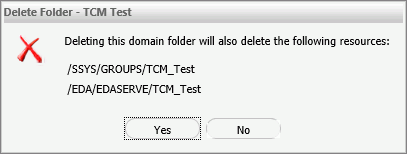Working With Domains
|
Topics: |
|
How to: |
The BUE uses Domains, and the groups of users they define, to support workgroups. Domains enable users to maintain private content, to share that content if their user role permits, and to access governed content published by others. Domains are available to multiple users, who, based on their role, have access to their own view of the Domain. This built-in workgroup security makes your data analysis and reporting activities easier to configure and manage.
In the Resources tree, Domains appear as root-level folders under the Domains node.
Domains comprise a collection of groups, an Application folder on the Reporting Server, and a set of rules that makes them all work together in a single workgroup. Domains partition content and metadata, and enable Managers to organize and store your content in the BUE portal. They are the place where Developers and Advanced Users create and manage content.
Procedure: How to Create a Domain
Only a Manager can create a Domain.
- In the Resources tree, right-click Domains,
point to New, and then click Domain.
The New Domain dialog box opens.
- Type a title and a name.
Domain titles are shown to BUE users in the Resources tree. Managers can localize the title for different languages by going into the Property dialog after the Domain is created.
The Domain name is an internal identifier used by BUE, and is not shown to users.
- Click OK to create the Domain.
A confirmation dialog appears. Click OK.
A folder that contains the title of the new Domain appears below the Domains node in the Resources tree.
Note: Within the new Domain, the BUE creates a Hidden Content folder as well as a My Content folder for each user. The Hidden Content folder can be used to store things that are related to the Domain but which you do not want users to see. For example, schedules that distribute output back to the Domain and image files or style sheets that are used by charts. The My Content folder is used by each user to store their personal content. Some users can share personal content with Domain users. Domain Developers and Managers can create folders and content within the domain and publish it so Domain users can access and interact with it.
Managing Domain Users
When a Manager creates a new Domain, the WebFOCUS Business User Edition automatically creates a new group for the Domain itself, and creates subgroups for each of the four user types within it. A Domain accommodates multiple users, maintaining independent views and levels of availability for each one. By assigning users to different groups within a Domain, a Manager or Group Administrator can set security options for each user at the Domain level.
To review these groups, open the Security Center. From there, a Manager can create new users for these Domain groups or add existing users to them. For more information about Groups, see Managing Groups.
Granting Access to a Domain
When a Manager first creates a Domain, it is available only to the Manager that created it.
To update this setting, the Manager must right-click a Domain, point to General Access, and then select one of the following settings.
- Domain Groups. Protects the Domain by limiting its availability to those users who are assigned to it and work within it. This is the default setting for all new Domains.
- All Users. Gives everyone Basic User access to the Domain. Using this setting, the Manager that created the Domain can make content and resources available to all users in a single action instead of individually assigning each user to the Domain.
The four Domain groups represent the four user types: Basic User, Advanced User, Developer, and Group Administrator. When the Manager or a Group Administrator assigns users to one of these groups, those users automatically obtain the privileges assigned to the user role represented by that group when working with content in that Domain.
Managing Domain Private Resources
The Manage Private Resources feature allows Managers and Group Administrators to identify and manage private resources owned by users or groups. In the BUE, Managers can manage private resources by user, group, or Domain.
Deleting Domains
|
How to: |
A domain can only be deleted by a manager who has rights to delete all of the resources within it.
The process that deletes a domain first removes all users from groups in the domain, and then cascade deletes the groups and rules that were created with it.
Note: The cascade delete process only removes users from groups within a domain. It does not delete the users themselves.
Procedure: How to Delete a Domain
- In the Resources tree, right-click an item, and then click Delete.
You receive a message advising you that this process will delete all resources created by this domain folder, as shown in the following Image.

- Click Yes to delete the domain and associated resources.
- If you receive a message warning that the folder contains private content, click OK to delete the domain and its private content.
If you need to protect the private content, click Cancel to end the process without deleting the domain.
When the process is complete, evidence of the domain and its resources disappear from the Resources tree and the Security Center.
Managing Domain Users After Deleting a Domain
Even though deleting a Domain automatically deletes the groups associated with it, this action does not delete the users assigned to those groups. Users from the deleted groups remain in the Users pane in the Security Center, but, unless they are assigned to another group, they are limited to view only privileges. To completely remove users from deleted groups, a Manager must delete them from the Security Center.
| WebFOCUS | |
|
Feedback |